This study was supported by grants from the Hoso Bunka Foundation, which was established by NHK, the public broadcasting firm in Japan, and was presented at International Institute of Communications, Annual Conference, September 6-9, 1989, Paris France.
RESULTS
I. How long do parents allow infants and toddlers to watch TV?
According to our population survey of three communities, the TV set was turned on at home for more than 6 hours a day in more than 40% of the families (Fig. 2). Thirty percent of parents let 3-month-old infants watch TV for more than an hour, while 12-month-old infants did so in 90% of the families surveyed. When mothers encourage TV viewing, nearly 70% of the infants glance or watch intently at the age of 3 months, and nearly 100% do so at 12 months. Infants and toddlers watch television for a surprisingly longer time than anticipated, especially when there are older siblings.
II. What attitude do parents, particularly mother, take toward television?
III. What kind of behavior do children exhibit toward television?
IV. What do the infants and toddlers do when the TV is on?
In order to observe the behavior of infants and toddlers and their parents when TV is on, we conducted an observation study in a playroom furnished as a living room. The findings of our observations are as follows
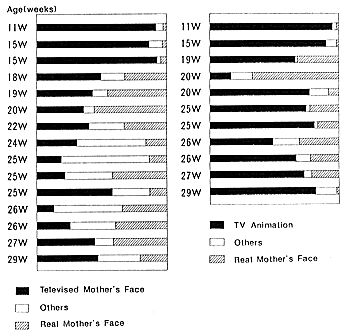
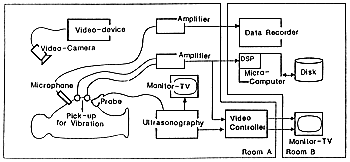
INTRODUCTION
Pediatricians have become aware of new kind of morbidity and mortality in pediatrics which were not described in textbooks twenty years ago. These newly appearing "diseases" tend to occur most often in affluent society. Although still very controversial, some pediatricians think that television may influence a child's mind to such an extent as to cause these new diseases, particularly forms of violence, delinquency and learning difficulties.
The American Academy of Pediatrics took action on this problem in 1984, by appealing to limit broadcasting of adult-type television programs containing pornography, violence and the like during times children might have access. The French Pediatric Association very recently took similar action. Unfortunately, there has been as yet no follow-up study made after such action was taken in the United States.
The Japan Pediatric Society has also considered this issue, and sponsored an Open Symposium in 1985 on "Television and Children". Harmful effects of television might have on children were not discussed, however. Television generally has been accepted in Japan as a beneficial educational tool at home and in the classroom.
No one can deny that television has a dark as well as a bright side, as does every social medium. For school children and adolescents in particular, television may produce negative effects due to the objectionable qualities of some television programs. The infrastructure of daily life, such as disturbances in parents-infant bonding, quality of schooling, and emotional support during adolescence must also be considered, and the role of television in a daily life at both home and school has to be clarified.
Most families in Japan have at least one television set, and more than half have two or more. At present there are over two hundred television stations, both public and commercial, distributed throughout the country. In Tokyo, various programs are broadcast continuously on over twelve channels from 6 A.M. to midnight, including news, documentaries, movies, dramas, stories, variety shows and, of course, commercial programs with advertising. Among such programs are a considerable number of educational programs in the fields of science, literature, history, art, music and others for both school-age children and adults. There are, however, only a limited number of programs for younger children; among which the best known are "Play with Mama" from a public station and "Hirake Ponkikki" from a commercial station. There are, as a whole, about 90 minutes a day devoted to special programs for younger children.
The influence of television on infants or toddlers has seldom been studied, although to date there are numerous studies concerning older children. To clarify the television's effect on infants, toddlers and fetuses, we have conducted a interdisciplinary project study for the last two years with the idea that information from television might also be meaningful to infants.
A population survey and an anthropological study were performed to determine the positive and negative roles of TV in the daily lives of infants and their families (Fig. 1). Observation and experimental studies were then conducted to confirm results more precisely using computer technology. We also studied the effects of TV on fetuses and their mothers, although the method applied was limited.
In this paper we summarize our studies and discuss both the positive and negative influences of television, and suggest preventive measures against possible negative effects.
Fig. 1 Influences of Television on Child
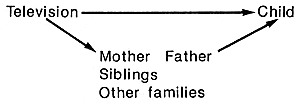

RESULTS
I. How long do parents allow infants and toddlers to watch TV?
According to our population survey of three communities, the TV set was turned on at home for more than 6 hours a day in more than 40% of the families (Fig. 2). Thirty percent of parents let 3-month-old infants watch TV for more than an hour, while 12-month-old infants did so in 90% of the families surveyed. When mothers encourage TV viewing, nearly 70% of the infants glance or watch intently at the age of 3 months, and nearly 100% do so at 12 months. Infants and toddlers watch television for a surprisingly longer time than anticipated, especially when there are older siblings.
Fig. 2 How Long Do Infants View TV?
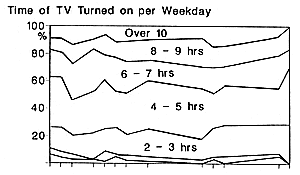
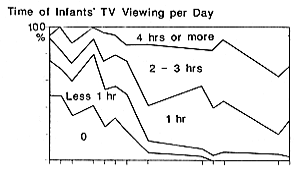
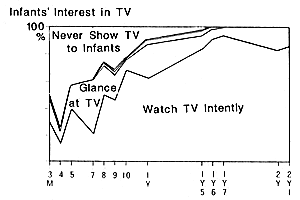



II. What attitude do parents, particularly mother, take toward television?
Attitudes of the parents toward television are also of interest (Fig. 3). Over 40% of parents make rules regarding children's TV viewing habits. Nearly 60% of the parents surveyed are trying to limit children's TV viewing, particularly at meal time. Parents also select special programs for infants and toddlers, such as "Play with Mama", "Hirake Ponkikki" and some animation or educational music programs for younger children.
No clear differences were found in children's TV viewing habits in urban and rural communities.
Fig. 3 Parents' Attitude toward TV
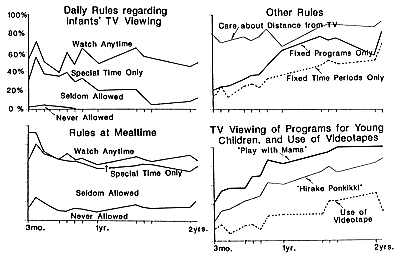

III. What kind of behavior do children exhibit toward television?
A population survey demonstrated that the behavior of infants and toddlers toward television is closely related to their physical and mental development (Fig. 4). Children are first exposed to the audio and video stimulations of TV shortly after birth to the age two months; they begin to have interest in and glance at or watch the TV screen at four to five months of age; when they are able to crawl they approach and investigate the TV set, and enjoy switching channels at seven to eight months; they become interested in and speak to the on-screen characters at 10 to 11 months; They have favorite TV characters and programs, and enjoy TV as "ordinary TV viewers" and move their bodies with the music and mimic the actors on-screen, smile and ask questions of parents after 12-14 months of age (Fig. 5). They fix the information from TV in their memory and are pleased to see the things they like on TV.
In most families, parents sing along, dance along, or explain program contents when the child is watching TV. Parents also use TV as a child care tool.
Anthropological studies revealed that parents had changed their attitude toward their child's TV viewing habits in conjunction with the child's development and behavior toward TV.
Fig. 4 Infants' Behavior toward TV
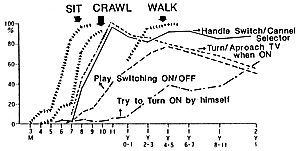

Fig. 5 Changes of Infants' Behavior toward TV along their Development
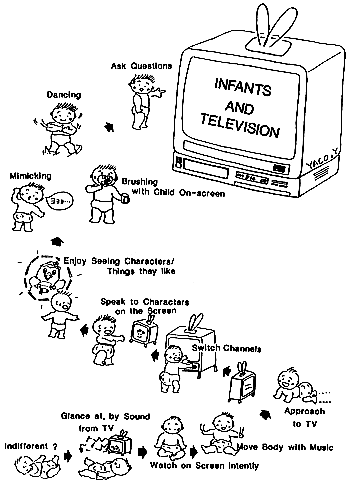

IV. What do the infants and toddlers do when the TV is on?
In order to observe the behavior of infants and toddlers and their parents when TV is on, we conducted an observation study in a playroom furnished as a living room. The findings of our observations are as follows
- Infants had quite short attention spans and only watched scenes that were of interest to them.
- Infants and toddlers "view TV with antennae", that is, they turn to see the TV when they hear the audio portion and start to watch if the program is interesting. They stop watching when the program is boring, or if they receive other sounds or movements in the room. Even while playing with their back turned toward the TV, young children are alert to the change of programs using their ears as "antennae" to pick up the sounds (Fig. 6).
- Infants and toddlers enjoy TV viewing with variety of behavioral manifestations - smiling at the beginning of their favorite programs, approaching the TV set and pointing at characters or things, singing along with characters on the screen, mimicking a dance, and turning and smiling at their mothers after these reactions (Fig. 7).
Fig. 6 "TV Viewing with Antennae" of Infants
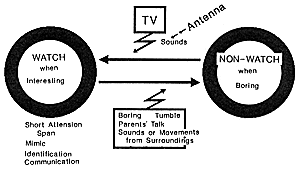

Fig. 7 TV Viewing with Various Manifestations
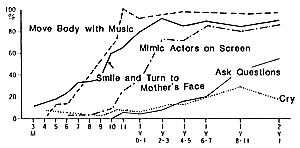

V. What programs and characters do infants and toddlers prefer?
The population survey clearly demonstrated infants' preferences in TV programs. They prefer cheerful scenes or commercials with infants, children, stuffed dolls, animals and cars, and those containing rhythmical sounds, as well as the more typical programs for young children having animated cartoons, music and puppet plays. They refuse to watch frightening, weird scenes or horror stories even in animation programs.
VI. Did young infants watch their real mother or televised mother more in the psychological experimental study?
We conducted a spontaneous preference test on 15 young infants between the age of 11 and 29 weeks. We found that the younger the babies are, the more they prefer watching their mother's televised face (on screen) and animated video picture (Dancing Crazy Donald Duck), than their mother's real face (Fig. 8).
Fig. 8 Do Infants Watch their Real Mother or Televised Mother?

VII. Did infants recognize the character on the screen in their brain?
In general, Event Related Potential P300 (a positive wave at 300 microseconds) in EEG(electroencephalogram) recording is observed in adults when they are stimulated by special events with sounds and/or pictures, which indicates the objective activation of nerve cells in the brain and their recognition and expectation of events.
The P300 potential was clearly observed both when a 8-month-old infant was shown his televised mother and when a 4-year-old child was shown a popular animated cartoon character on a TV screen, although the P300 potential was not observed when the subjects were shown uninteresting pictures of an egg on screen. Findings indicate that even infants may recognize pictures on television just as well as adults.
VIII. Does the television disturb the visual development of children?
Most parents express concern about effects on sight development when infants and toddlers watch TV at very close distances. Using eye tests, we studied the relationship between TV viewing habits of young children and their sight development. No discernable difference in sight characteristics was observed between a group of 25 children who watch TV more than 1 hour per day and a group of 31 children who watch less than 1 hour per day. Surprisingly, for children less than two years old, sight development is faster in those who watch TV for longer periods (Table 1).
Table. 1 Development of Sight
| Watching Child | Non-watching Child | |
| mean Age | 12.5 month | 11.8 month |
| number of test | 22 | 22 |
| mean Sight | 0.25 | 0.97 |
| mean + 1SD | 0.146 - 0.443 | 0.108 - 0.357 |
IX. How does the fetuses respond, when the mother is watching television?
As may be expected, pregnant women are also television viewers. It is important to assess the effects of television on fetal development. Of course, the abdominal wall, amniotic fluid and clothing filter the emissions from the TV, and only sound, particularly rhythm, can reach the fetus.
It was clearly shown that fetal heart beat was accelerated or decelerated and fetal movement was activated when the mother was watching television, at a movie, or listening to music. The reactions may have been induced by the music directly coming from the television and by the mother's emotional state induced by the state of watching or listening.
We theorized that, if a fetus could vocalize in uterus, it might hum when it enjoyed the music during the mother's TV viewing. Can a fetus vocalize? We know that lip movement, mouth opening, head turning, arm movement, thorax movement and other behavior of the neonate are followed by vocalization. We observed similar movements of the fetus by ultrasonic monitoring, and realized the possibility of fetal vocalization in uterus. Attempts were made to detect fetal voice using specially devised instruments (Fig. 9), but we have not yet succeeded. This lack of success could be due to the fact that fetal voice in uterus is too low in frequency and energy to be distinguished from vibrations resulting from hand movement or the like.
Further investigation is needed since it is well known that many premature babies are able to cry immediately after birth.
Fig. 9 Instruments to Catch Fetus' Cry

X. Is television a useful tool for detecting children with sensory handicaps?
Out of 1,616 questionnaires in our survey of television viewing behavior, we found a single response indicating abnormal behavior in a toddler. Follow-up clinical examinations disclosed this toddler was hearing-impaired. Thus, we accidentally identified a handicapped child by noting abnormal television viewing behavior.
On the basis of this finding, we conducted an observation study to assess the behavior of handicapped children toward television in an experimental environment. The following findings were obtained.
Three subjects with impaired hearing showed unique behavior. 1) They preferred to play by switching the TV channels. 2) They did not notice the change in TV programs by themselves and became aware of it when their mothers pointed it out (finger pointing).
Three subjects with impaired vision also showed atypical attitudes. 1) They listened to TV sounds without looking at the TV set. 2) They moved their bodies with rhythms which were different in style to those of normal infants. 3) They did not turn toward the direction of any sounds.
Two subjects with disturbed eye movements exhibited peculiar postures and oblique head positions, particularly when viewing TV intently.
All of the above subjects enjoyed TV viewing in spite of our various behavior tests.
Children exhibiting abnormal behavior while viewing television should be given more sophisticated tests at a clinic to assure early detection of handicaps.
These findings have important clinical implications. We need to develop new sensory test methods using television, since we know that present methods are not always efficient due to the emotional upset which such testing produces in infants and toddlers. Clearly, children like TV and respond to TV even if they cannot react to medical tests.
CONCLUSION
We know that human beings are information seekers, and that children are born with developmental programs for the body and mind as well as with an organization of sensitive antennae consisting of the eyes, ears, nose, mouth, and skin to receive information from the surrounding environment for their survival.
Our studies indicate clearly that the TV stimulation for infants must be meaningful information rather than noise, and that even infants will select television programs they find interesting. When babies are confronted with uninteresting programs they will immediately start playing with something else, such as a favorite toy, or turn to their mother, but their ears remain receptive to changes of TV and surroundings.
Our studies, although limited to particular areas in Japan, reveal that many present day parents who grew up in the age of television utilize TV in intelligent ways. Television is used as a tool in child care as an adjunct to playing peekaboo, singing lullaby, looking at picture books, and playing with rattles and the like. There is a triangular familial interaction among parents, infants and television.
The possibility of withdrawing television from the Japanese family no longer exists. Therefore, means must be studied for making more effective use of television for child care at home and for educating parents in more effective methods of child care. When put to such use, television is important since the nuclear family is on the increase in our society, and traditional method of learning child care from parents is no longer possible. It is therefore my strong belief as a pediatrician that television organisations should consider this situation more carefully when planning their daily programming. They should not forget the enormous power they hold over the parents and children in any society.
Our survey indicates an important problem with a few parents who watch TV all day long, or use the TV as a convenient "baby-sitter" for their children over long periods. Public service and educational television should consider preventive measures to guide these parents to a healthier attitude toward TV viewing and child care. Many issues remain to be investigated. For example: Dose early television viewing disturb parents-infant interaction? Does this habit disturb the development of a reading habit? Does this habit disturb language development? Can the TV viewing habit be decreased?
Finally, humans are information seekers by nature. Throughout the history of human evolution, we have developed cave paintings, ideographs and letters, parchment, books, printing machines, computers and the like. Television is a new medium and one of the most effective means of transferring information. A child's body grows with good nutrition and the mind develops with information. We pediatricians have to accept television as a new means for child care and develop deeper biological and cultural insights to such an end. Simply limiting broadcasting activity alone will not solve the problems arising from the negative aspects of television. We must make structural approaches of child ecology based on developmental behavioral science and sociocultural medical anthropology, as well as, through community administration and cooperation of the broadcasting institutions. We, pediatricians, have important responsibility for it.
Remarks: We have to think that the infants subjected to our study have reached to the lower teenagers. They are presently rising new-media such as handy phones, pagers and other devices for home as well as school activities including friend making.














